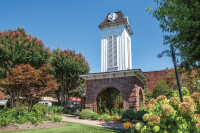Beech tree retains its tropical bark characteristics
A concept among biologists is that of “keystone species:” plants or animals with a pervasive influence on community composition and inter-reactions. In the eastern United States — especially here in the southern highlands — the beech tree is such an item. Enter a stand of beech and you immediately sense you’ve penetrated a special zone: a world of lover’s initials, dangling wind chimes, dense leaf-litter, and smooth silvery-gray or blue-gray trunks.
In Western North Carolina the beech appears as a dominant species in hardwood coves and hemlock forests up to 6,000 feet, being conspicuously absent in situations where oaks and pines prevail. At higher elevations pure stands called “beech gaps” appear in the regions just below spruce-fir forests, along ridge tops, and in gaps. In the high Smokies they can be readily observed on the main divide between Newfound Gap and Indian Gap adjacent to the Clingmans Dome road and along the Flat Creek Trail near Balsam Mountain Campground. But they are not difficult to locate throughout the region.
The origin of these “beech gaps” has been attributed to the fact that beeches have “the ability to withstand great wind damage,” to the browsing effects of cattle that “cropped them a few feet from the ground causing them to be quite thick,” and other causes such as the fact that the species — like hemlock — is quite shade tolerant while at the same time sending up shoots from older roots, which take over when the parent tree dies. It’s a complex phenomenon still being pondered by the scientific community.
The beech tree is easily identified in winter because of its tendency to retain dried leaves instead of immediately dropping them in the fall. Unlike most deciduous trees, beeches don’t fully form the corky “abscission” layer between the leaf stems and twigs that separates when activated by cold weather; so many of them hang on until pushed off by next year’s leaves.
“Why has beech developed smooth bark when all of its northern deciduous associates have developed rough back?” Tom Wessels asks in Reading the Forested Landscape (Countryman Press, 1997). And then he provides the answer:
“Deciduous trees [that evolved] in the northern forests have developed adaptations in their bark to guard against frost cracking. One of these adaptations is rough bark texture in the form of scales, ridges, or plates … American beech is a member of the Fagaceae – a family of trees that evolved in the tropics [where] trees must contend with epiphytes – plants that grow on trees … An adaptation to thwart an epiphyte’s ability to find a ‘roothold’ is smooth bark. Although beech grows into Quebec, it retains its tropical adaptation of smooth bark, compensating it with light coloration to reflect winter sunlight.”
Related Items
Oak trees, which are in the same family (Fagacae), also retain leaves. But whereas oaks have thick brown leaves that rustle dully in the wind, beech leaves form thin papery — almost translucent — tan curls. When these catch a breeze it might seem as if the woods are hung with tiny wind chimes.
Even after the leaves do fall, they persist on the forest floor. This results from the fact that the carbon to nitrogen ration in the leaves is over 50 to 1. Leaves of trees like sugar maples and elms, with a ratio of about 20 to 1, decompose in about a year. Beech, pine, and oak leaves and needles require over three years. So, when you enter the “beech community” you find it has wall-to-wall carpeting.
Such a setting invariably attracts gaffiti lovers who, alas, somehow know that beech bark is nature’s best for carving hearts and arrows, initials signifying eternal attachments, and other sublime messages. The bark looks like skin because it’s very thin. With the living tissue so close to the surface it scars easily when the tree is carved and swells into puckered humps that accentuate bear claw marks and love-struck hieroglyphics alike.
Daniel Boone inscribed an east Tennessee beech: “D. Boone Cilled A Bar/On Tree/In Year 1760.” The scars, if not the exact wording, were still visible in 1916 when the tree — 28 feet in girth, 70 feet tall, with an estimated age of 365 years — fell to earth.
Year round it seems we are drawn irresistibly to the complex forest communities in which the beech tree is the major player. From spring into summer, the stands become cool glades. In late fall, sunlight filters through the lingering yellow leaves and envelopes a visitor in the golden light of Indian summer. In winter, direct light reflects off the smooth ghostly-gray bark and catches the eye from afar.
George Ellison wrote the biographical introductions for the reissues of two Appalachian classics: Horace Kephart’s Our Southern Highlanders and James Mooney’s History, Myths, and Sacred Formulas of the Cherokees. In June 2005, a selection of his Back Then columns was published by The History Press in Charleston as Mountain Passages: Natural and Cultural History of Western North Carolina and the Great Smoky Mountains. Readers can contact him at P.O. Box 1262, Bryson City, N.C., 28713, or at This email address is being protected from spambots. You need JavaScript enabled to view it..









